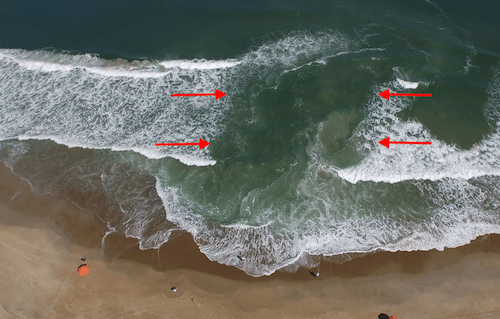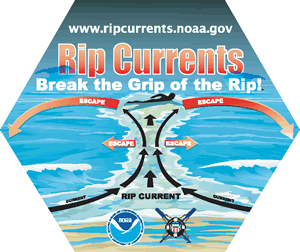How do I escape rip currents?
Beachgoers sometimes see scary looking warning signs telling them to watch out for rip currents. “Rip” in this case could stand for “rest in peace,” because these currents can be deadly. In the U.S., about 100 people drown in rip currents every year. Lifeguards in the U.S. rescue another 30,000 swimmers from rip currents each year.
We usually think of waves as washing stuff onto the beach—seaweed, shells and other ocean debris. But sometimes the waves hit the beach in a certain way to create a current that flows away from the beach. This is a rip current. When waves travel from deep to shallow water, they break near the shoreline and generate currents that are influenced by the shape of the ocean floor, at times producing rip currents. Waves interacting with each other can also cause short-lived rip currents.

Rip currents are often difficult to see, but you can spot them in areas where waves aren’t breaking, or where there’s foam, seaweed, or discolored water being pulled offshore (area marked by red arrows). Image credit: NOAA Ocean Today (modified)

Credit: NOAA/JPL-Caltech
Rip currents may form around low spots in the ocean floor near the shoreline or in breaks between sandbars. They may also form around human-made structures such as jetties and piers. They vary from 50 to 300 feet wide. (A 4-lane highway is about 50 feet wide.) Limited as they are in size, you don’t want to get caught in a rip current while swimming. Rip currents typically flow at 1 to 2 feet per second. However, they have been known to flow as fast as 8 feet per second (about 5 miles per hour)—faster than an Olympic swimmer can sprint! They can sweep even the strongest swimmer out to sea.
Rip current speed is influenced by the size of the waves, but sometimes waves only two feet high can produce hazardous rips. Perhaps surprisingly, rip currents are strongest at low tide.
The shape of the ocean bottom sometimes changes during storms or when waves are particularly big. The ocean floor may suddenly have an ideal shape for creating unpredictable rip currents where there were none before.
Rip current vs. undertow
Don’t confuse a rip current with an undertow. Rip currents are much more dangerous, because they flow on the surface of the water, can be very strong, and can extend some distance from the shore. An undertow can occur when water sinks back downhill into the sea after a wave has carried it uphill onto the beach. Unless the beach has a steep incline, the undertow will probably not be very powerful. However, if the tide is high, the wave is large, and the beach slopes sharply downhill toward the water, the undertow could be strong enough to knock you down, but it won’t carry you far—maybe just far enough to get smacked by the next big wave coming in.
Rip tides? Nope!
You might have heard of something called “rip tides,” but this term is incorrect. Rip currents have nothing do with the tides, which are caused by the gravitational pull of the Moon on the whole ocean. Rip currents, on the other hand, are a purely local effect.
Download the NOAA rip current safety brochure. (PDF)




